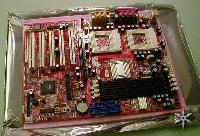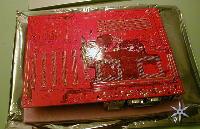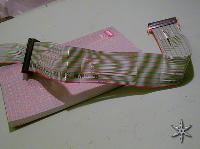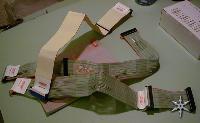After careful consideration I have decided to transfer all hardware review activities to a new domain. I purchased Hardwareasylum.com in 2012 and have been working hard to build a new and improved Ninjalane on that domain. If you are reading this you have reached one of the archived articles, news, projects and/or reviews that were left behind during the site migration.
Please update your bookmarks and be sure to visit the new and improved Ninjalane at Hardwareasylum.com
Freeway Design FWD-P3C4XD Motherboard Review
Author: Dennis Garcia
Published: Sunday, November 26, 2000
Features/Specifications
Board Features/specs page 2
Setting up the system was pretty easy, with everything documented in the manual. When setting up processors you can
allow the bios to choose the processor for you or you can define the processor based on three settings Host Clock speed,
CPU multiplier, and CPU voltage. All of these can be auto set by the bios and work quite well. If you choose to
set the FSB manually you will also need to set the multiplier for that processor. The FSB speeds are listed on the
spec sheet with a maximum unsupported speed of 166MHz.
During my testing I decided to allow the bios to decide on the proper CPU voltage and much to my surprise everything worked
just fine.
Memory settings can be very simple or quite specific, the settings are either Auto or you can define them based on the following criteria.
SDRAM CAS Latency
SDRAM RAS Precharge Time
SDRAM RAS Pulse width
SDRAM RAS to CAS Delay
From what I can tell these settings are global for all of the memory banks.
Along with these settings you can adjust the DRAM clock by 33 MHz +/- independent of the timing controls.
This motherboard also came with a variety of cables including a few signature pieces. In these pictures you will set the drive cables, one 80pin ATA66, one 40pin IDE and one floppy. The 40pin and floppy drive connectors are factory stranded and have a thicker insulation on them. On set intervals they do form a ribbon cable though simply pulling the wires apart at those intervals yields a cable ready for "rounding". Even without pulling the wires apart the stranding of the ribbon allows more flexibility in the cable and ease of placement.
Memory settings can be very simple or quite specific, the settings are either Auto or you can define them based on the following criteria.
SDRAM CAS Latency
SDRAM RAS Precharge Time
SDRAM RAS Pulse width
SDRAM RAS to CAS Delay
From what I can tell these settings are global for all of the memory banks.
Along with these settings you can adjust the DRAM clock by 33 MHz +/- independent of the timing controls.
This motherboard also came with a variety of cables including a few signature pieces. In these pictures you will set the drive cables, one 80pin ATA66, one 40pin IDE and one floppy. The 40pin and floppy drive connectors are factory stranded and have a thicker insulation on them. On set intervals they do form a ribbon cable though simply pulling the wires apart at those intervals yields a cable ready for "rounding". Even without pulling the wires apart the stranding of the ribbon allows more flexibility in the cable and ease of placement.





